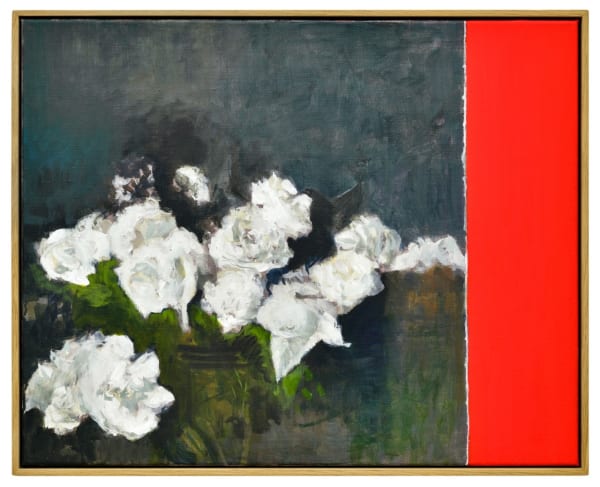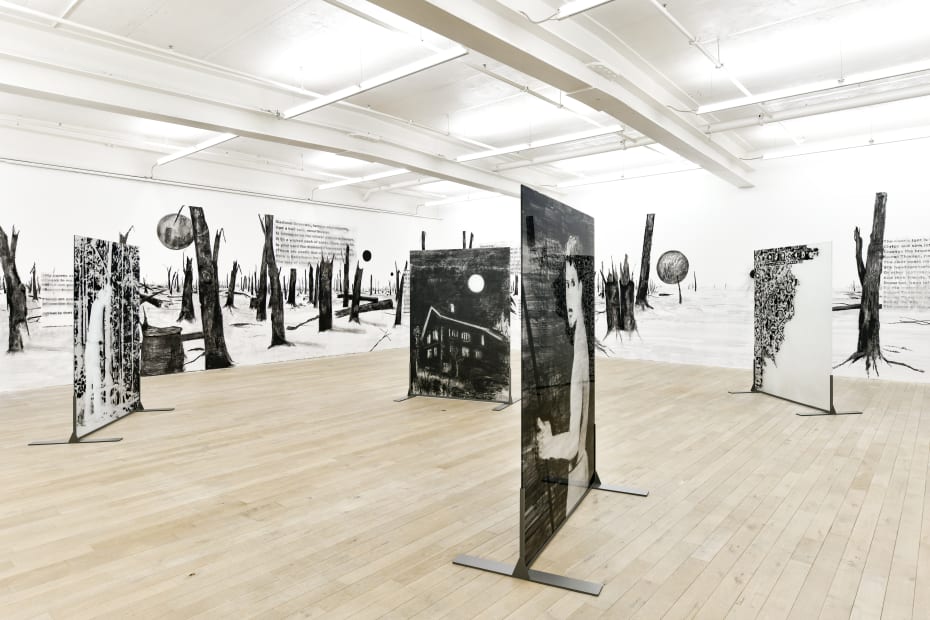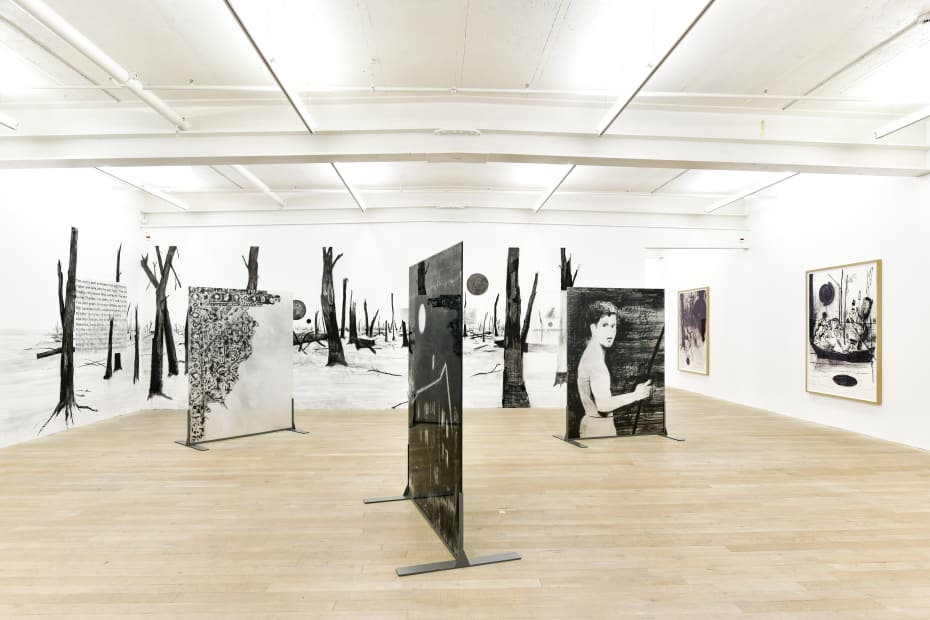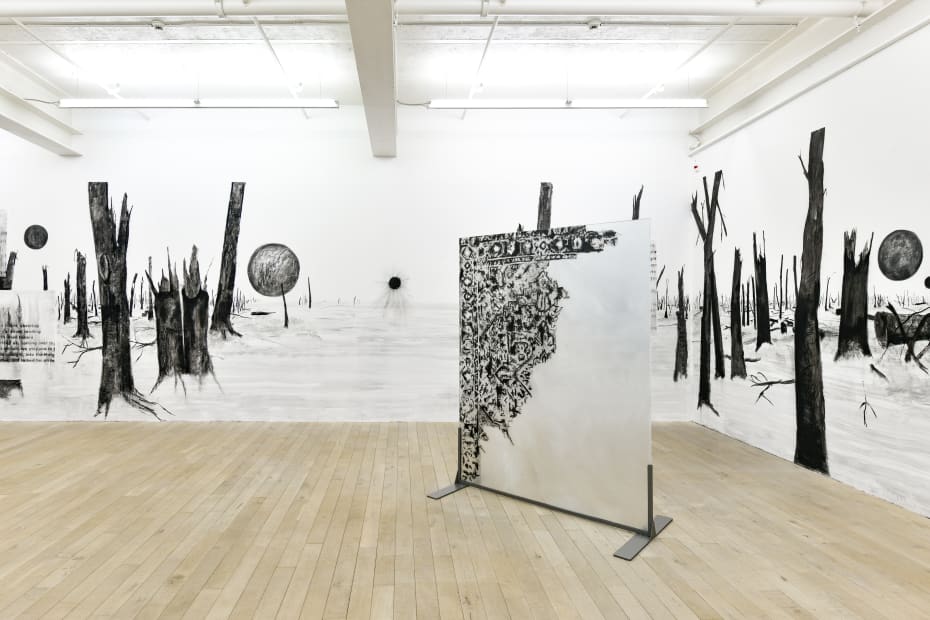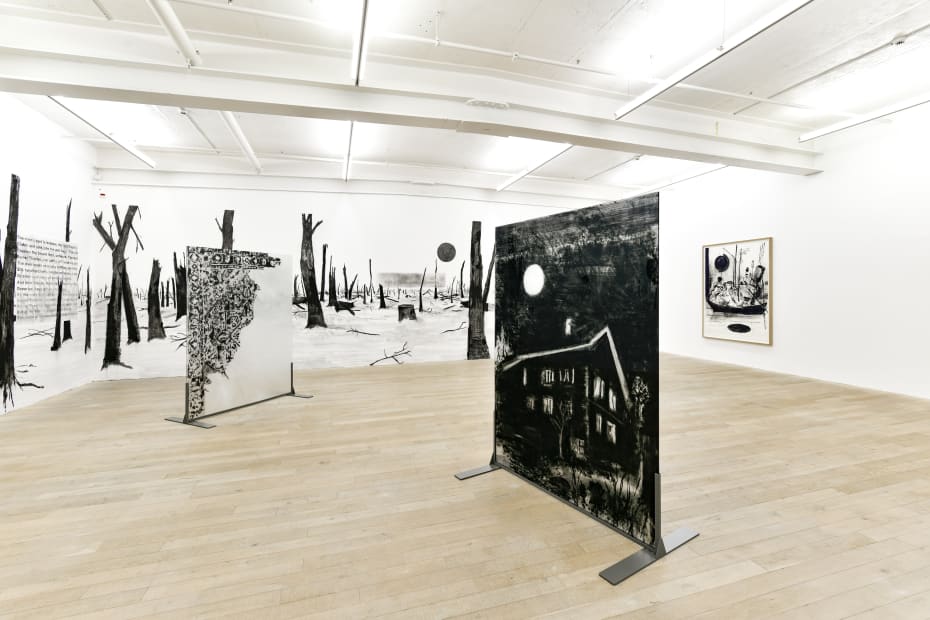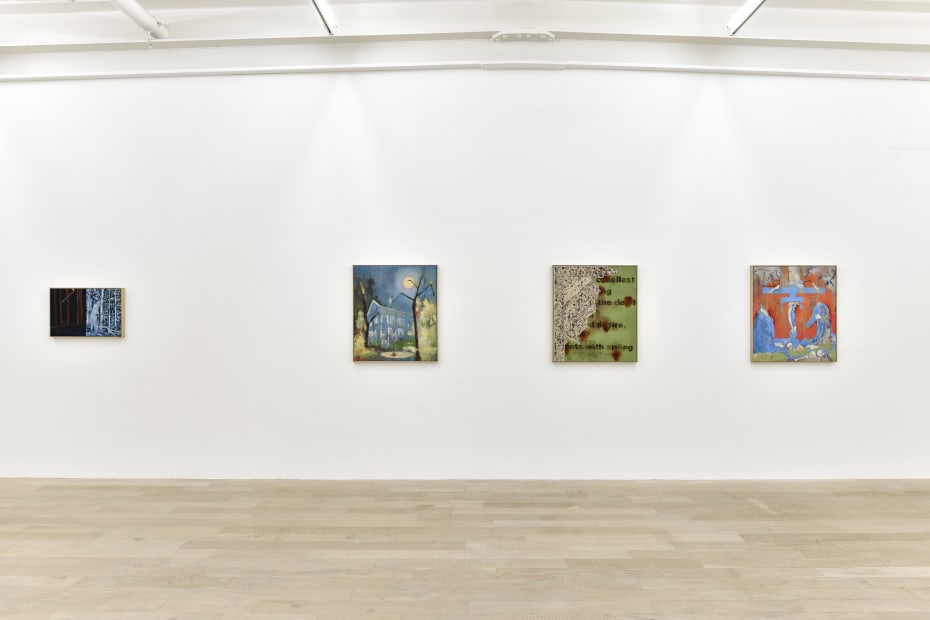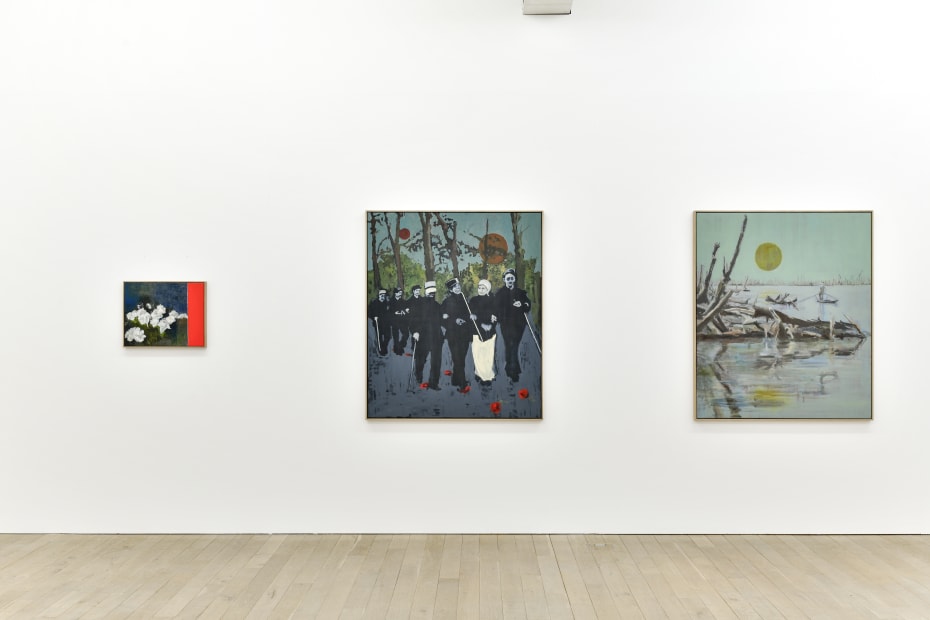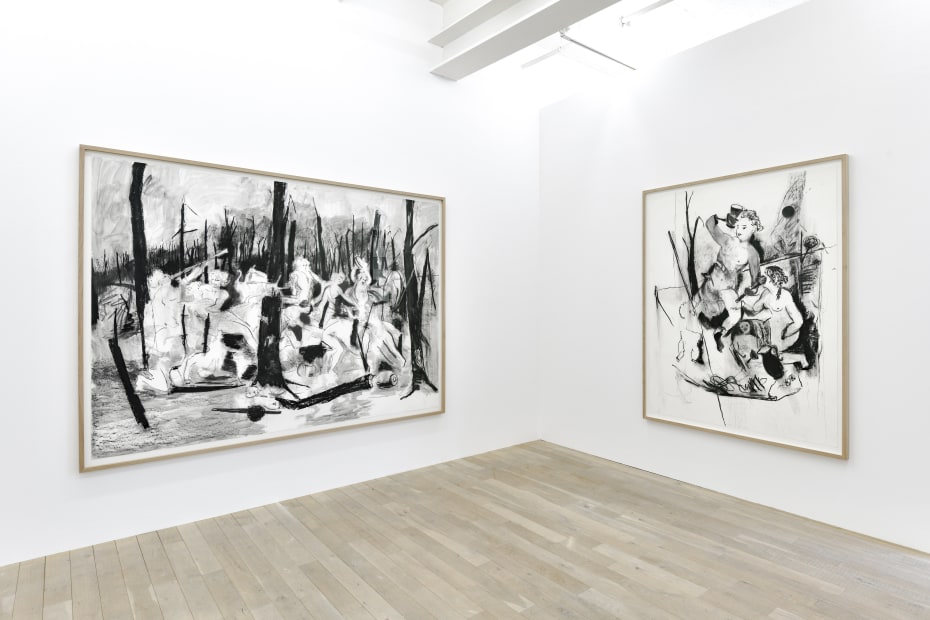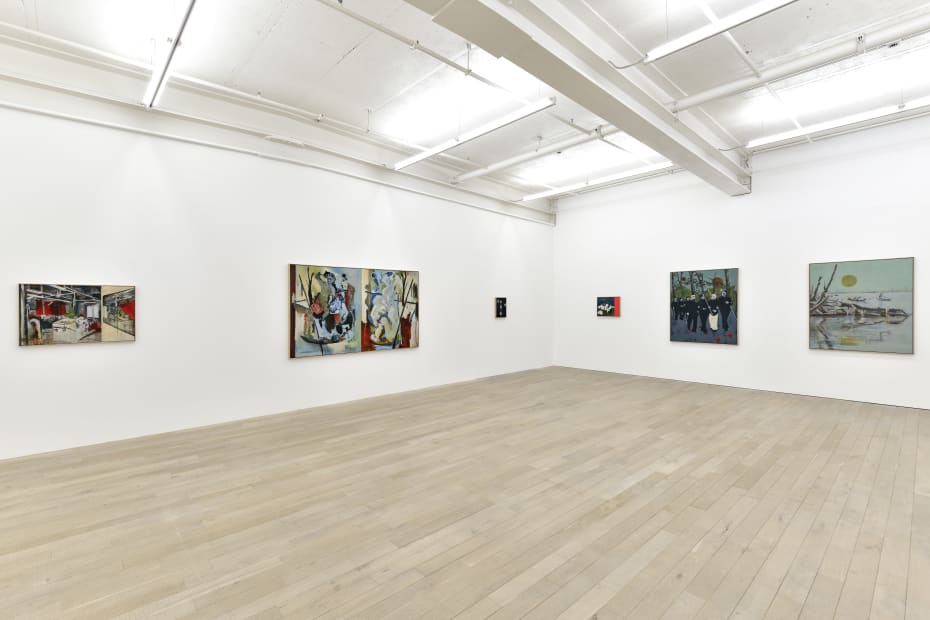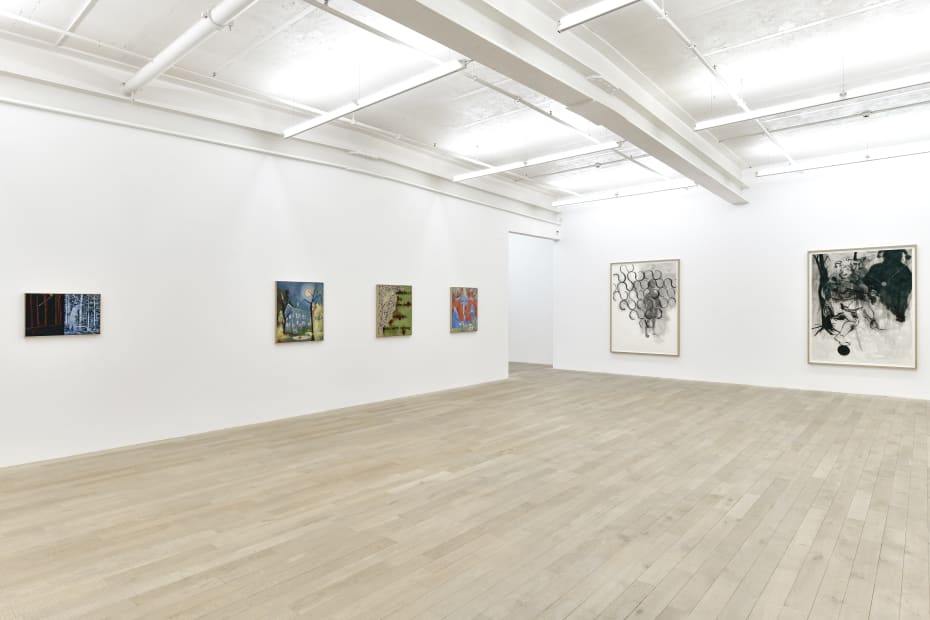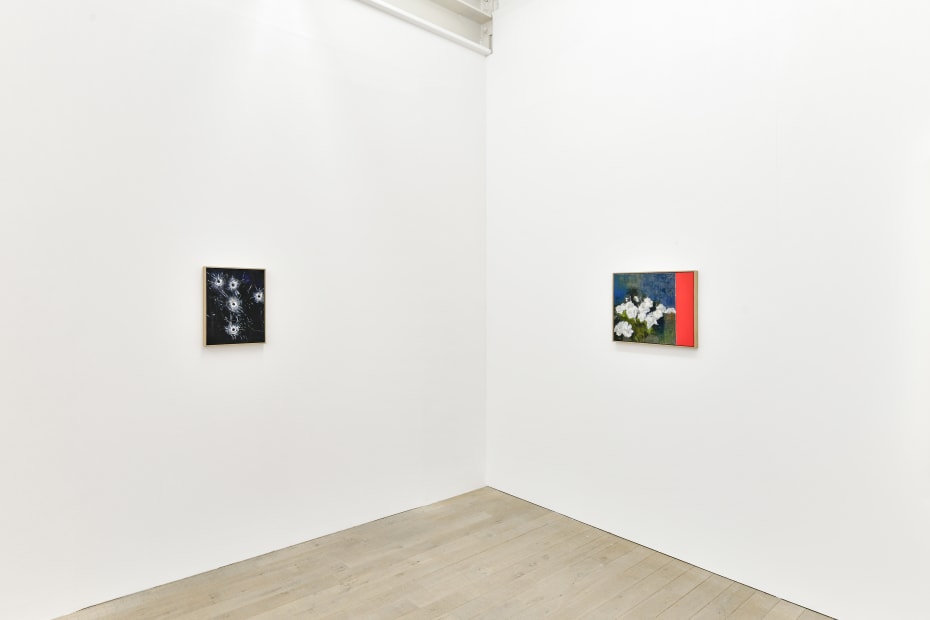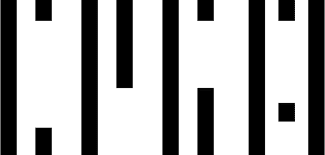Uwe Wittwer: Holzfäller.SpiegelGalerie Peter Kilchmann, Zahnradstrasse, Zurich
Galerie Peter Kilchmann is pleased to announce Holzfäller.Spiegel (Woodcutter.Mirror), the second solo exhibition of Swiss artist Uwe Wittwer (*1954 in Zurich, lives and works there) at the gallery at the Zahnradstrasse. Wittwer will occupy all three spaces of the gallery for the exhibition. The new group of works will interweave historical and fictional subjects with autobiographical elements from the artist's life, forming a web of cultural references around collective and personal memory.
-
 Uwe WittwerWaldweg (Forest Track), 2021Wall drawing, charcoal on wallgal 1 Est: 300 x 934 cm
Uwe WittwerWaldweg (Forest Track), 2021Wall drawing, charcoal on wallgal 1 Est: 300 x 934 cm
gal 1 South: 300 x 1164 cm
gal 1 West: 300 x 934 cm
gal 1 Ost: 300 x 934 cm
gal 1 Süd: 300 x 1164 cm
gal 1 West: 300 x 934 cm -
 Uwe WittwerIm Walde (In the Woods), 2020Glass, painted on one side and burned, painted metal stand200 x 150 cm (78.7 x 59.1 in.)
Uwe WittwerIm Walde (In the Woods), 2020Glass, painted on one side and burned, painted metal stand200 x 150 cm (78.7 x 59.1 in.)
Metal stand: each side, 39 cm / total depth, 80 cm -
 Uwe WittwerHolzfäller.Spiegel (Woodcutter.Mirror), 2020Diptych, oil on canvas40 x 60 cm (15.7 x 23.6 in.)
Uwe WittwerHolzfäller.Spiegel (Woodcutter.Mirror), 2020Diptych, oil on canvas40 x 60 cm (15.7 x 23.6 in.)
42 x 62 cm (16.5 x 24.4 in.), framed -
 Uwe WittwerDas Braumeisterhaus (The Brewmaster's house), 2020Oil on canvas80 x 70 cm (31.5 x 27.6 in.)
Uwe WittwerDas Braumeisterhaus (The Brewmaster's house), 2020Oil on canvas80 x 70 cm (31.5 x 27.6 in.)
82 x 72 cm (32.3 x 28.3 in.), framed -
 Uwe WittwerWandstück (Wallpiece), 2020Oil on canvas80 x 70 cm (31.5 x 27.6 in.)
Uwe WittwerWandstück (Wallpiece), 2020Oil on canvas80 x 70 cm (31.5 x 27.6 in.)
82 x 72 cm (32.3 x 28.3 in.), framed -
 Uwe WittwerInterieur (Interior), 2020Oil on canvas60 x 90 cm (23.6 x 35.4 in.)
Uwe WittwerInterieur (Interior), 2020Oil on canvas60 x 90 cm (23.6 x 35.4 in.)
62 x 92 cm (24.4 x 36.2 in.), framed -
 Uwe WittwerTrauriger Bacchus (Sad Bacchus), 2020Dipytch, oil on canvas130 x 220 cm (51.2 x 86.6 in.)
Uwe WittwerTrauriger Bacchus (Sad Bacchus), 2020Dipytch, oil on canvas130 x 220 cm (51.2 x 86.6 in.)
132.5 x 222.5 cm (52.2 x 87.6 in.), framed -
 Uwe WittwerStillleben nach Fantin Latour (Still Life after Fantin Latour), 2020Oil on canvas40 x 50 cm (15.7 x 19.7 in.)
Uwe WittwerStillleben nach Fantin Latour (Still Life after Fantin Latour), 2020Oil on canvas40 x 50 cm (15.7 x 19.7 in.)
42 x 52 cm (16.5 x 20.5 in.), framed -
 Uwe WittwerAuf dem Berg. nach F. Lippi (On the mountain. after F. Lippi), 2020Oil on canvas80 x 70 cm (31.5 x 27.6 in.)
Uwe WittwerAuf dem Berg. nach F. Lippi (On the mountain. after F. Lippi), 2020Oil on canvas80 x 70 cm (31.5 x 27.6 in.)
82 x 72 cm (32.3 x 28.3 in.), framed -
 Uwe WittwerNarrenschiff (Ship of Fools), 2020Charcoal on paper180 x 134 cm (70.9 x 52.8 in.)
Uwe WittwerNarrenschiff (Ship of Fools), 2020Charcoal on paper180 x 134 cm (70.9 x 52.8 in.)
192 x 145 cm (75.6 x 57.1 in.), framed -
 Uwe WittwerIm Wäldchen nach Poussin (Into the woods after Poussin), 2020Charcoal on papersheet 180 x 240 cm (70.9 x 94.5 in.)
Uwe WittwerIm Wäldchen nach Poussin (Into the woods after Poussin), 2020Charcoal on papersheet 180 x 240 cm (70.9 x 94.5 in.)
191.5 x 261 cm (75.4 x 102.8 in.), framed
anti-reflective glass
(UV 72 protection) -
 Uwe WittwerWäldchen (Copse), 2020Charcoal on papersheet 180 x 134 cm (70.9 x 52.8 in.)
Uwe WittwerWäldchen (Copse), 2020Charcoal on papersheet 180 x 134 cm (70.9 x 52.8 in.)
192 x 145 cm (75.6 x 57.1 in.), framed
anti-reflective glass
(UV 72 protection)








